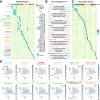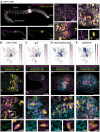Annelid adult cell type diversity and their pluripotent cellular origins
- PMID: 38609365
- PMCID: PMC11014941
- DOI: 10.1038/s41467-024-47401-6
Annelid adult cell type diversity and their pluripotent cellular origins
Abstract
Many annelids can regenerate missing body parts or reproduce asexually, generating all cell types in adult stages. However, the putative adult stem cell populations involved in these processes, and the diversity of cell types generated by them, are still unknown. To address this, we recover 75,218 single cell transcriptomes of the highly regenerative and asexually-reproducing annelid Pristina leidyi. Our results uncover a rich cell type diversity including annelid specific types as well as novel types. Moreover, we characterise transcription factors and gene networks that are expressed specifically in these populations. Finally, we uncover a broadly abundant cluster of putative stem cells with a pluripotent signature. This population expresses well-known stem cell markers such as vasa, piwi and nanos homologues, but also shows heterogeneous expression of differentiated cell markers and their transcription factors. We find conserved expression of pluripotency regulators, including multiple chromatin remodelling and epigenetic factors, in piwi+ cells. Finally, lineage reconstruction analyses reveal computational differentiation trajectories from piwi+ cells to diverse adult types. Our data reveal the cell type diversity of adult annelids by single cell transcriptomics and suggest that a piwi+ cell population with a pluripotent stem cell signature is associated with adult cell type differentiation.
© 2024. The Author(s).
Conflict of interest statement
The authors declare no competing interests.
Figures










Update of
-
Annelid adult cell type diversity and their pluripotent cellular origins.bioRxiv [Preprint]. 2023 Apr 26:2023.04.25.537979. doi: 10.1101/2023.04.25.537979. bioRxiv. 2023. Update in: Nat Commun. 2024 Apr 12;15(1):3194. doi: 10.1038/s41467-024-47401-6. PMID: 37163014 Free PMC article. Updated. Preprint.
References
MeSH terms
Substances
Grants and funding
LinkOut - more resources
Full Text Sources
Molecular Biology Databases

